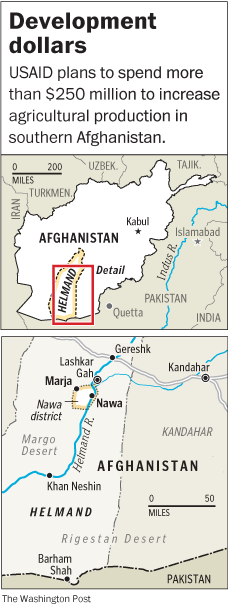
– USAID’s “burn rate” in Afghanistan: $300 million a month –
By Rajiv Chandrasekaran
NAWA, AFGHANISTAN — In this patch of southern Afghanistan, the U.S. strategy to keep the Taliban at bay involves an economic stimulus.
Thousands of men, wielding hoes and standing in knee-deep muck, are getting paid to clean reed-infested irrigation canals. Farmers are receiving seeds and fertilizer for a fraction of their retail cost, and many are riding around on shiny new red tractors. Over the summer, dozens of gravel roads and grain-storage facilities will be constructed — all of it funded by the U.S. government.
Pumping reconstruction dollars into war zones has long been part of the U.S. counterinsurgency playbook, but the carpet bombing of Nawa with cash has resulted in far more money getting into local hands, far more quickly, than in any other part of Afghanistan. The U.S. Agency for International Development’s agriculture program aims to spend upward of $30 million within nine months in this rural district of mud-walled homes and small farms. Other U.S. initiatives aim to bring millions more dollars to the area over the next year.
Because aid is so plentiful in Nawa — seemingly everyone who wants a job has one — many young men have opted to stop serving as the Taliban’s guns for hire. Unlike neighboring Marja, where insurgent attacks remain a daily occurrence, the central parts of Nawa have been largely violence-free the past six months.
But the cash surge has also unleashed unintended and potentially troubling consequences. It is sparking new tension and rivalries within the community, and it is prompting concern that the nearly free seeds and gushing canals will result in more crops than farmers will be able to sell. It is also raising public expectations for handouts that the Afghan government will not be able to sustain once U.S. contributions ebb.
“We’ve blasted Nawa with a phenomenal amount of money in the name of counterinsurgency without fully thinking through the second- and third-order effects,” said Ian Purves, a British development expert who recently completed a year-long assignment as the NATO stabilization adviser in Nawa.
U.S. officials responsible for Afghanistan policy contend that the initiative in Nawa, which is part of a $250 million effort to increase agricultural production across southern Afghanistan, was designed as a short-term jolt to resuscitate the economy and generate lasting employment. They say concerns about overspending are misplaced: After years of shortchanging Afghans on development aid, the officials maintain that they would rather do too much than too little.
“Our goal is to return Nawa to normalcy, to get folks back to their daily lives of farming, and that requires a large effort,” said Rory Donohoe, USAID’s agriculture program manager in Helmand province.
Of particular concern to some development specialists is USAID’s decision to spend the entire $250 million over one year in parts of just two provinces, Helmand and Kandahar. In Nawa, which has a population of about 75,000, that works out to about $400 for every man, woman and child. The country’s per-capita income, by comparison, is about $300 a year.
“This is a massive effort to buy people off so they won’t fight us,” said a U.S. development officer in southern Afghanistan.
The spending here is a preview of what the Obama administration wants to accomplish on a larger scale. USAID’s “burn rate” in Afghanistan — the amount it spends — is about $300 million a month and will probably stay at that level for at least a year.
ATTENTION READERS
We See The World From All Sides and Want YOU To Be Fully InformedIn fact, intentional disinformation is a disgraceful scourge in media today. So to assuage any possible errant incorrect information posted herein, we strongly encourage you to seek corroboration from other non-VT sources before forming an educated opinion.
About VT - Policies & Disclosures - Comment Policy



